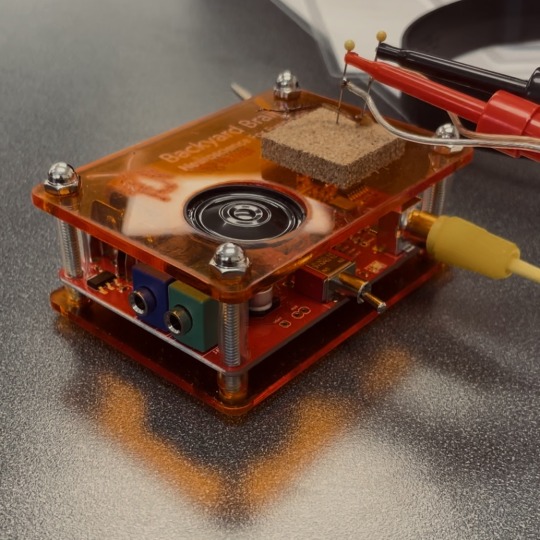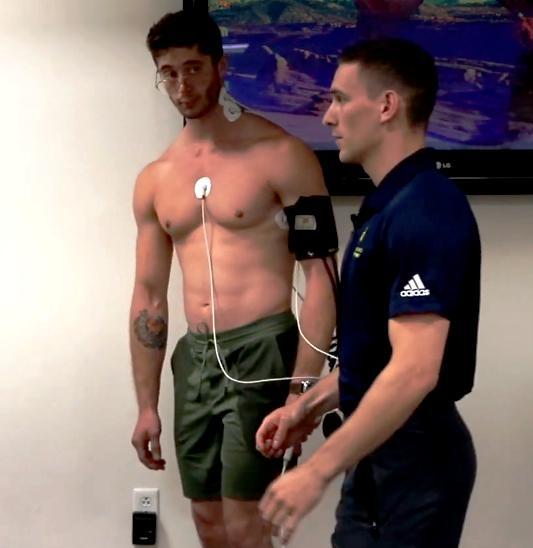#electrophysiologically
Text




2024-02-02
New semester new me — not really though, despite my highest hopes. It’s only the end of the first week and I’ve already got work piling up. Absolutely wild.
#bottom left is an electrophysiology workshop I went to#we made a cockroach leg dance to cotton eye joe#disclaimer: no cockroaches were harmed during this experiment#they were anethetized and legs grow back in 3 months#studyblr#studyspo#study aesthetic#aesthetic#student#my posts#study#chaotic academia#stem academia
19 notes
·
View notes
Text
Embarking on a Scholarly Expedition: Unraveling the Electric Tapestry of the Heart's Symphony ⚡️💓
Greetings, inquisitive minds! Today, I invite you to join me on a deep dive into the intricacies of the heart's electric system – a symphony conducted by an ensemble of specialized cells, choreographing the rhythm of life itself. 📚🔬
1. The Sinoatrial (SA) Node: The Maestro of the Orchestra
Our exploration commences with the illustrious SA node, a cluster of cells nestled elegantly in the right atrium. As the heartbeat's maestro, the SA node plays a pivotal role in initiating the electric impulse. Picture this natural pacemaker as the conductor, setting the tempo for the graceful dance of atrial contraction.
2. Atrioventricular (AV) Node and the Bundle of His: The Harmonious Transition
Moving seamlessly through our cardiac composition, we encounter the AV node – a bridge connecting the atria to the ventricles. This crucial junction ensures a harmonious transition, much like the bridge between movements in a musical masterpiece. Following this, the electric wave traverses the Bundle of His, a specialized pathway conducting the impulse with precision.
3. Ventricular Contraction: The Grand Crescendo
In the grand finale, our symphony reaches its pinnacle as the ventricles contract in orchestrated unison. This powerful crescendo propels blood throughout the circulatory system, marking the culmination of the heart's electric ballet.
As aspiring scholars, let's delve into these references, unraveling the secrets of this physiological masterpiece. Envision the heart's electric symphony, appreciate the precision required for this grand performance, and together, let's celebrate the wonders of medical science! 💡🧠🎓

#science#biology#college#education#school#student#medicine#doctors#health#healthcare#electrophysiology#physiology#nursing
18 notes
·
View notes
Text

the muscle guy is volunteering for some electrode action
58 notes
·
View notes
Text
Kind of a stressful day with drs appointments 2hrs away being cancelled and a whole bunch of other bs but my test results were good!
#they didn’t test my kidneys for some reason#but they did do like a fluid test of some sort#and it was fine#the appointment today was electrophysiology and they cancelled without calling me#and I had to call 3 fucking people to find out wtf was going on
10 notes
·
View notes
Video
undefined
tumblr
Light-activated Bacteria
Neuroscientists have had the monopoly on using light-activated proteins to induce electrical impulses in cells. This ability to control cell firing at the flick of a switch has revolutionised research into the brain, but brain cells are not the only electrical cells in nature. It’s understood, for example, that changes in microbial cell electrophysiology regulate all sorts of processes including spore production, biofilm formation and susceptibility to antibiotics. With this in mind, researchers have now adapted tools previously used in neurons for use in bacteria. The bacteria in the video contain such photoswitch proteins and, when exposed to light for 10 seconds (every 10 minutes), become negatively charged (hyperpolarised) – seen as a pulse of blue colour. As a proof-of-concept experiment, these flashing bacteria open the door for research into various aspects of microbial electrophysiology and pave the way for developing synthetic bacteria whose functions can be controlled by light.
Written by Ruth Williams
Video from work by Tailise Carolina De Souza-Guerreiro and colleagues
School of Life Sciences, University of Warwick, Coventry, UK and Center for Nanoscience and Technology, Istituto Italiano di Teconologia, Milano, Italy
Video originally published with a Creative Commons Attribution 4.0 International (CC BY 4.0)
Published in Advanced Science, January 2023
You can also follow BPoD on Instagram, Twitter and Facebook
22 notes
·
View notes
Text
just had my first electrophysiology appointment and they confirmed everything again, started me on meds, AND referred me for testing for a disorder with high comorbidity to mine!!
feeling so so hopeful 🥰
#lexi talks#personal blog#stoner witch#southern witch#pagan witch#witchcraft#paganism#paganblr#queer pagans#pagan#potsie#pots syndrome#electrophysiology#heds#ehlers danlos syndrome#hypermobility
4 notes
·
View notes
Text
my doctor: remember you need to take a dose of your heart medication before bed or else you will have The Symptoms.
Me, an entire neuroscience researcher, baffled that I still have a heartbeat at night: o:
#I was really SO taken aback#I’m like knee deep in fucking electrophysiology#but the idea that my organs exist when I’m sleep….
3 notes
·
View notes
Text
at least this time the textbooks have cool names
#physicochemical hydrodynamics‚ renal electrophysiology‚ boundary layer theory!!!#banger after banger
3 notes
·
View notes
Text
Electrophysiology Market: Transforming Cardiac Care with Advanced Diagnostics
The Electrophysiology market is witnessing significant growth as cardiovascular diseases (CVDs) continue to be a leading cause of mortality worldwide. With advancements in diagnostic technology, electrophysiology is revolutionizing cardiac care by enabling precise diagnosis and treatment of heart rhythm disorders. This article explores the key market trends, segmentation, growth drivers, and leading companies shaping the electrophysiology industry.
Market Overview
According to SkyQuest’s Electrophysiology Market report, the market is currently valued at USD 8.20 billion in 2023, with a projected CAGR of 13%. The increasing prevalence of heart diseases, growing adoption of minimally invasive procedures, and advancements in electrophysiology devices are propelling the market forward.
Request Your Free Sample: - https://www.skyquestt.com/sample-request/electrophysiology-market
Market Segmentation
By Product Type:
Electrophysiology Ablation Catheters: Key devices for treating arrhythmias through minimally invasive procedures.
Electrophysiology Diagnostic Catheters: Widely used in diagnosing electrical activity in the heart.
Electrophysiology Lab Devices: Includes mapping systems and recording devices for advanced diagnostics.
Pacemakers and Defibrillators: Crucial for regulating heart rhythms in patients with severe arrhythmias.
Others: Includes specialized tools and equipment for electrophysiological procedures.
By Indication:
Atrial Fibrillation: One of the most common cardiac arrhythmias, where electrophysiology plays a significant role in treatment.
Atrioventricular Nodal Reentrant Tachycardia (AVNRT): A fast heart rhythm disorder often treated with ablation.
Wolff-Parkinson-White Syndrome (WPW): A rare condition where electrophysiology diagnostics are essential for management.
Other Arrhythmias: Includes ventricular tachycardia and flutter, both addressed through electrophysiology treatments.
By End-User:
Hospitals: Major centers for electrophysiology procedures and treatments.
Ambulatory Surgical Centers: Increasingly adopting electrophysiology for outpatient treatments.
Cardiac Centers: Specialized in diagnosing and treating heart rhythm disorders.
Others: Includes research institutions and academic centers focused on cardiac care.
Key Growth Drivers
Rising Incidence of Cardiovascular Diseases: The global rise in heart diseases is fueling demand for advanced electrophysiology diagnostics and treatments.
Technological Advancements: Innovations in catheter ablation, 3D mapping systems, and minimally invasive procedures are enhancing the market's growth potential.
Growing Preference for Minimally Invasive Surgeries: Electrophysiology procedures are less invasive, leading to faster recovery times, which is driving their adoption.
Increased Healthcare Spending: Governments and healthcare providers are investing heavily in cardiac care, boosting the demand for electrophysiology solutions.
Read More at: - https://www.skyquestt.com/report/electrophysiology-market
Leading Companies in the Market
SkyQuest’s report highlights key players dominating the Electrophysiology Market, including:
Johnson & Johnson
Abbott Laboratories
Medtronic PLC
Boston Scientific Corporation
Siemens Healthineers AG
MicroPort Scientific Corporation
Biotronik SE & Co. KG
GE Healthcare
Koninklijke Philips N.V.
Biosense Webster, Inc.
Take Action Now: Secure Your Report Today - https://www.skyquestt.com/buy-now/electrophysiology-market
Challenges and Opportunities
High costs associated with electrophysiology procedures and devices pose a challenge, especially in developing regions. However, the ongoing research and development efforts to create cost-effective and advanced devices offer vast opportunities for market growth. The increasing availability of mobile healthcare services and remote diagnostics also opens new avenues for expansion.
Future Outlook
The Electrophysiology Market is poised for continued growth, driven by technological advancements and the increasing burden of cardiovascular diseases globally. Companies that focus on developing innovative and cost-effective solutions are well-positioned to capitalize on the growing demand for electrophysiology procedures.
As the need for effective cardiac care intensifies, the electrophysiology market is at the forefront of diagnostic and treatment innovations. Healthcare providers and decision-makers must stay updated with the latest trends and technologies to ensure optimal patient outcomes. For a detailed analysis and strategic insights, consult SkyQuest's comprehensive Electrophysiology Market report.
0 notes
Text
https://social.studentb.eu/read-blog/188737_electrophysiology-catheter-ablation-market-size-analysis-and-forecast-2031.html
The Electrophysiology Catheter Ablation Market in 2023 is US$ 3.82 billion, and is expected to reach US$ 7.25 billion by 2031 at a CAGR of 8.32%.
#Electrophysiology Catheter Ablation Market#Electrophysiology Catheter Ablation Market Trends#Electrophysiology Catheter Ablation Market Growth
0 notes
Text
Pulsed Field Ablation: The Next Big Thing In Medical Device Technology

Advancements in medical device technology are helping doctors treat conditions in less invasive ways. One such innovation is pulsed field ablation (PFA), a new method for treating cardiac arrhythmias without the need for open-heart surgery. This cutting-edge technique uses pulsed electric fields to safely create precise non-thermal lesions in the heart muscle.
How Does PFA Work?
Pulsed Field Ablation works by delivering high-intensity electric pulses to targeted cardiac tissue through electrodes. These nanosecond pulses are able to penetrate cell membranes without causing irreversible electroporation, thereby ablating the tissue in a non-thermal manner. The electric fields disrupt cell membranes only in the immediate vicinity of the electrodes, allowing for creation of very precise and controlled lesions without affecting surrounding healthy tissues.
This is a major advantage over older ablation techniques that rely on temperatures to ablate. With PFA, there is no thermal energy transfer so the risk of collateral damage is minimized. Researchers have demonstrated in animal studies that PFA can accurately target and treat arrhythmias with precise ablation lesions and no perforation of cardiac chambers.
Potential For Treating Complex Arrhythmias
Pulsed field ablation shows great potential for treating complex arrhythmias that have been difficult to manage using existing techniques. Its ability to create tailored, millimeter-sized lesions could help treat conditions like atrial fibrillation originating from multiple focal points in the heart muscle. Precisely targeting these areas is challenging with temperature-based radiofrequency ablation.
PFA may also help defeat arrhythmias located near arteries, veins or conducting tissues where thermal energy risks unintended coagulation or vessel damage. The elimination of thermal effects makes it safer for treating arrhythmias very close to the esophagus as well. Its non-thermal mechanism could expand treatment eligibility for elderly patients or those with comorbidities precluding the heat effects of older ablation technologies.
Clinical Trial Results Are Promising
Several medical technology companies are developing PFA systems and have initiated early human trials. Results so far have been very encouraging. In a 30-patient study of PFA for atrial fibrillation, symptoms were successfully eliminated in over 90% of participants with no serious adverse events. Follow-up showed the majority remained arrhythmia-free over a year later.
Another trial on 25 patients with recurrent ventricular tachycardia or ventricular fibrillation after heart attack also demonstrated strong efficacy and safety. Over 80% of participants saw complete resolution of their arrhythmia episodes post-ablation. Key investigators noted the consistent, homogenous lesions achieved with PFA were larger than anticipated and resulted in fewer treatment touches compared to standard radiofrequency ablation.
Regulatory Approval And Commercialization Plans
Given these positive results, manufacturers are working to seek regulatory clearances from the FDA and CE Mark approval in Europe over the next 1-2 years to commercially launch PFA systems. With approval, PFA could start replacing radiofrequency as the primary approach for most catheter ablations by 2025 according to analysts. Billing codes are also being established to ensure insurance coverage.
This innovation could be highly transformative for the multi-billion dollar cardiac ablation device if large clinical trials confirm its advantages over legacy technologies. Hospitals stand to benefit from shorter procedure times, reduced complication risks and ability to treat more complex cases. For patients, PFA promises less invasive and more effective treatment of cardiac arrhythmias without the side effects of temperature-based ablation. Its arrival could help address the growing epidemic of atrial fibrillation worldwide.
Pulsed field ablation is an exciting new method for cardiac ablation that overcomes many limitations of existing temperature-based techniques. Early human data validates its superior safety profile and ability to precisely target arrhythmias. Regulatory clearances in the next two years should enable the commercial launch of PFA systems. This technology could revolutionize the field of electrophysiology and meet a major unmet need in arrhythmia care. Pending larger clinical outcomes, PFA appears well poised to become the new gold standard for catheter ablation procedures.
Get more insights on this topic: https://medium.com/@colinwilson306/pulsed-field-ablation-a-revolutionary-new-laser-technology-70d0e4e03b19
About Author:
Ravina Pandya, Content Writer, has a strong foothold in the market research industry. She specializes in writing well-researched articles from different industries, including food and beverages, information and technology, healthcare, chemical and materials, etc. (https://www.linkedin.com/in/ravina-pandya-1a3984191)
*Note:
1. Source: Coherent Market Insights, Public sources, Desk research
2. We have leveraged AI tools to mine information and compile it
#Pulsed Field Ablation#Electroporation in Cardiology#Cardiac Ablation Therapy#Non-thermal Ablation Technology#Cardiac Electrophysiology Innovation
0 notes
Text

volunteering for electrophysiology experiments.
26 notes
·
View notes
Text
The Electrophysiology Devices Market will grow at highest pace owing to increasing prevalence of cardiac arrhythmias

The electrophysiology devices market comprises electrophysiology ablation catheters, electrophysiology laboratory devices, electrophysiology diagnostic catheters, and access devices. Electrophysiology ablation catheters are minimally invasive catheters used to treat arrhythmias by delivering energy to the areas of irregular electrical signals in the heart. Electrophysiology laboratory devices include 3D mapping systems and intra-cardiac echocardiography (ICE) systems used to guide electrophysiology procedures and ablation catheters. Electrophysiology diagnostic catheters comprise recording and multielectrode diagnostic catheters inserted into the heart to help doctors map electrical signals and diagnose arrhythmias. Access devices such as sheaths and guidewires support entry of other catheters into the heart during electrophysiology procedures. The growing prevalence of cardiac arrhythmias and technological advancements in electrophysiology devices are major factors expected to drive market growth. The Global Electrophysiology Devices Market is estimated to be valued at US$ 7,756.5 Mn in 2024 and is expected to exhibit a CAGR of 12.% over the forecast period 2023 to 2030.
Key Takeaways
Key players operating in the electrophysiology devices market are General Electric Company, Biotricity, Medtronic, VivaQuant, Inc., Johnson & Johnson Services, Inc., AliveCor, Inc., Bittium, Nihon Kohden Corporation, Shimmer, OMRON Healthcare, Co., Ltd., VivaLNK, Inc., Abbott, BIOTRONIK, Boston Scientific Corporation, MicroPort Scientific Corporation, Koninklijke Philips N.V., Siemens Healthcare GmbH, HeartSciences, anumana, Inc., and Omega Medical Imaging, LLC. Medtronic and Abbott hold a major share of over 55% of the market.
The electrophysiology devices market is mainly driven by the rising prevalence of cardiac arrhythmias globally. According to the Centers for Disease Control and Prevention, approximately 2.7 to 6.1 million people in the U.S. suffer from atrial fibrillation. Atrial fibrillation increases the risk of stroke by nearly 5 times.
Technological developments are expected to provide opportunities for growth in the electrophysiology devices market. Major players are focusing on developing advanced electrophysiology devices with features such as integrated systems, remote monitoring capabilities, catheter miniaturization, and irrigated-tip catheters. For instance, Medtronic launched the StealthStation S8 system with advanced 3D visualization and navigation capabilities for complex ablation procedures.
Market Trends
One of the key trends in the electrophysiology devices market is the growing demand for robotic systems. Robotic systems offer advantages over conventional manual systems such as improved ergonomics, optimal catheter control and stability, and integration of 3D mapping and imaging capabilities. For example, the Stereotaxis Niobe ES system is a magnetic navigation system that allows robotic control of catheter movement for complex ablation procedures.
#Electrophysiology Devices Market Growth#Electrophysiology Devices Market Analysis#Electrophysiology Devices Market Demand
0 notes
Text
Electrophysiology Market Outlook from 2024 to 2034

The Global Electrophysiology Industry is poised for unprecedented growth, with Future Market Insights (FMI) forecasting a remarkable surge to reach US$ 9,078.4 billion by 2034 from US$ 4,350.7 billion in 2024. The market is projected to exhibit a robust Compound Annual Growth Rate (CAGR) of 7.6% over the forecast period.
Request a Sample Copy of the Report Nowhttps://www.futuremarketinsights.com/reports/sample/rep-gb-5268
0 notes
Text
Service Dogs Lead to Fewer Seizures in Resistant Epilepsy
New Post has been published on https://petn.ws/j5cN2
Service Dogs Lead to Fewer Seizures in Resistant Epilepsy
Working with medically trained service dogs is associated with a 31% reduction in seizures compared with usual care in treatment-resistant epilepsya new study showed. Investigators speculate that the dogs may ease participants’ stress, leading to a decrease in seizure frequency, although they note this relationship warrants more study. “Despite the development of numerous antiseizure medications […]
See full article at https://petn.ws/j5cN2
#DogNews #AnxietyDisorder, #Electrophysiology, #Epilepsy, #HealthRelatedQualityOfLife, #Hrqol, #MedicalLife, #MedicalLifestyle, #MedicalStudentLifestyle, #NurseLifestyle, #PhysicianLifestyle, #QOL, #QualityOfLife, #ResidentLifestyle, #SeizureDisorder, #Seizure, #Stress, #WoundCare, #WoundManagement
#anxiety disorder#electrophysiology#epilepsy#health related quality of life#hrqol#medical life#medical lifestyle#medical student lifestyle#nurse lifestyle#physician lifestyle#QOL#quality of life#resident lifestyle#seizure disorder#seizure.#stress#wound care#wound management#Dog News
0 notes